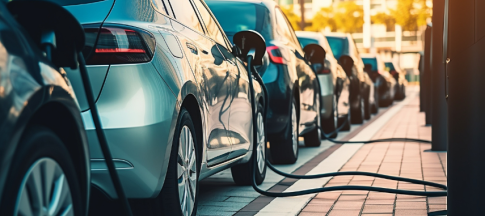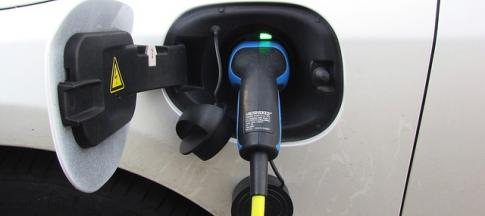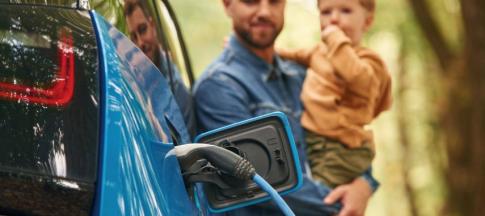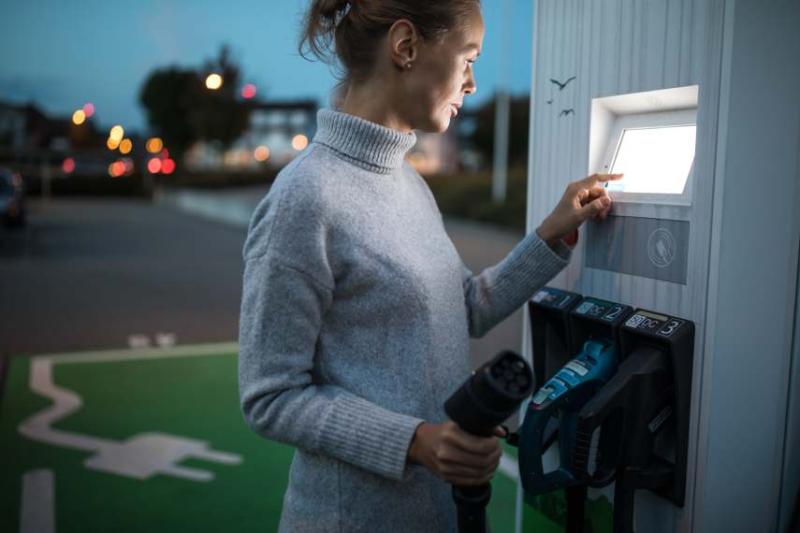
Charging an electric vehicle (EV) usually takes longer than filling up petrol and diesel cars and needs a little more planning.
But public charging networks grow every day, and the battery range of cars is improving. However, many new EV owners may get confused when they need to charge for the first time.
Below, we tell you all you need to know about how to charge an electric vehicle.
How electric vehicle charging works
Chargers pull electric current from the grid and deliver it to an EV via a connector or plug.
The EV then stores that electricity in a battery pack to power its electric motor.
How to charge an EV
Charging your EV is like charging your phone - some drivers charge their EVs overnight or while at work, while others stop off during journeys to take advantage of public charge points.
Charging the battery is simple:
- open the charging flap and insert the plug into it
- leave the plug until you have the required charge
- remove the plug, return to the charge point and close the flap
Where can I charge my car?
There’s more than one place that you can charge your EV.
Charging at home
Charging at home is the most convenient and cost-effective way to recharge an EV.
Government grants are available for installing home EV chargepoints (also known as wall boxes), which are typically rated at 3kW or 7kW.
You can plug electric vehicles into a standard three-pin plug at home. However, it takes longer to charge.
There are two types of home electricity tariffs:
- some offer cheaper electricity overnight, which is ideal for EV owners
- others are single-rate tariffs, where you pay the same rate throughout the day, but it's sometimes discounted if you run an EV
Contact your own energy supplier to find out more about your electricity rates.
Charging using a public connection
Home EV charging isn’t possible for many owners because they don’t have off-street parking.
They have no option but to use on-street residential EV charging or public chargers at service stations and supermarkets.
On the plus side, these chargers tend to be faster than domestic connections.
Make the public charging cable is out of the way of pedestrians when in use. It’s written in the Highway Code that users should try to prevent others tripping over the cable when it’s connected to the vehicle. You can avoid trip hazards by parking close to the charging point and even displaying a trip hazard warning sign.
Charging an EV at work
Many organisations have installed charging stations for staff, and it can be convenient during work.
As company cars switch to electric, it’s becoming more important for businesses to offer EV charge points.
Businesses, charities and local authorities can take advantage of the Workplace Charging Scheme, which incentivises reducing carbon emissions and helps with the upfront installation costs.
How to find a public charging point
Public charging points are common now, and you can find a public charge point here.
At the end of January 2024, there were 55,301 electric vehicle charging points across the UK, across 31,445 charging locations, according to the Zap-Map database. That’s a 48.4% increase from December 2022, wherein 37,261 EV charging points could be found across the UK.
AC or DC?
Electric vehicles use two kinds of fuel: alternating current (AC) and direct current (DC).
The power that comes from the grid is always AC, so EVs are fitted with a converter (or onboard charger), which converts AC to DC. It then feeds it into the battery, which is how ‘slow’ home charging works.
Faster public chargers use DC, which bypasses the converter altogether so the charge can go directly into the battery. This speeds up the charging process, which is why it's called fast, rapid or ultra-rapid charging.
How much does it cost to charge an EV?
The amount you pay to charge your EV depends on where you charge it and the price of electricity. Broadly, the faster the charger, the more it will cost to charge your EV.
For instance, pay-as-you-go rates are as high as 85p per kilowatt-hour (kWh) in the UK, according to Zap-Map. In comparison, at-home charging tariffs sit at around 32p per kilowatt-hour, according to Pod Point.
The amount you pay varies between providers, and it relies on the wholesale price of electricity.
Under the Government’s Energy Price Guarantee, the average dual fuel unit price for domestic electricity on standard variable tariffs with direct debit has a 28.62p per kWh limit, according to Ofgem. However, this guarantee only applies to households with a pre-payment meter.
For an electric vehicle, this equates to an average cost of about 8.17p per mile.
Smaller electric city cars might cost as little as 7p per mile to run, while larger SUVs could cost as much as 10p per mile, according to research by Which?.
However, drivers using rapid and ultra-paid chargers (which can cost twice the price per kilowatt hour) pay around 27p per mile.
In other words, if you can't charge at home and you rely on rapid public chargers, the cost saving of running an EV over a petrol or diesel car is negligible, and sometimes may even exceed the cost of running a petrol or diesel car.
How do I pay for charging?
Some chargepoints accept contactless credit or debit card payments, plus ApplePay, Google Pay and Android Pay. It’s very rare to find a chargepoint that accepts cash payments.
There are various public chargepoint networks in the UK, including Pod Point, Ionity, BP Pulse, Gridserve, Osprey and ChargePlace Scotland.
Access to charging is usually through a radio frequency identification (RFID) card or a smartphone app.
Some providers also have roaming agreements, meaning you can access a larger charger network.
How long does it take to charge an EV?
The length of time it takes to charge your EV comes down to five factors:
- battery size
- how much electric current the car handles
- charger speed
- battery charge
- desired charging level (usually 80% or 100%)
You can measure the size and power of a battery in kilowatt-hours (kWh). The larger the number, the bigger the battery, the longer it’ll take to recharge.
Chargers deliver electricity in kilowatts (kW), and they range from 3kW to 350kW. You won’t be able to get an extremely powerful EV home charger; these can only be found at superfast public charging stations, such as those offered by Tesla and Ionity.
Again, the higher the number, the quicker the charging rate.
EVs with a claimed range of 150 - 200 miles tend to have batteries around the 50kWh mark, while cars with longer ranges (300 miles) are 77.4kWh and above.
Should you charge to 80% or 100%?
Unless you're charging overnight at home, it's recommended to only fast charge to 80% because charging rates slow down dramatically past the 80% mark, plus the long-term health of the battery pack is improved when kept below 100%.
You can learn more about the little ins and outs of EVs in our electric vehicle mythbuster.
Types of electric vehicle chargers explained
Three-pin plug – a three-pin charger is useful if you arrive somewhere and there’s no dedicated charger, such as a friend’s house or holiday home. Manufacturers don't recommend it for daily usage.
Type 1 – these have a five-pin design with a low AC output of between 3.7kW and 7.4kW. They can be used at home.
Type 2 – these have a seven-pin design and can reach speeds of up to 43kW at public charge stations. As the most popular charger (which can be used at home), your EV will likely have this design.
CCS – the Combined Charging System (CCS) is a rapid and ultra-rapid DC charging connector capable of charging speeds up to 350kW. It’s only available at public charging stations and has nine pins in two sections. The upper AC section has seven pins - the lower has two additional pins, enabling a DC connection for faster charging speeds.
CHAdeMO – Toyota, Nissan and Mitsubishi established this Japanese DC charger. Popular models that use CHAdeMO include the Mitsubishi Outlander PHEV and Nissan Leaf. It has a DC power rating of 50kW and can be used at home.
Are charging points insured?
Our electric vehicle insurance protects your charging points and chargers, safeguarding them against accidental damage, fire and theft.
I'm an experienced journalist, digital editor and copywriter, now specialising in motoring. I’m editor of Automotive Blog and have worked across the media in newspapers, magazines, TV, teletext, radio and online for household names including the BBC, GMTV, ITV and MSN. I’ve produced digital content in the financial sector for Lloyds Bank, Nationwide and the Money Advice Service. I'm married with two children and live near Bath in Somerset.

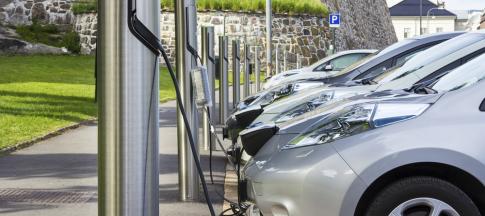 ,
, 